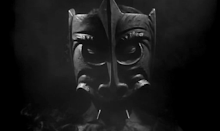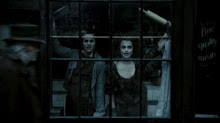I have just been informed that Quentin Tarantino is directing a Django movie WITH Franco Nero.
There is only one response to this.
"An Imaginary Museum"






Namely, director Francis Lawrence is responsible for my favorite bad movie of all time.
Yes I hold the purest bad movie affection for Constantine. It’s not a film that’s so bad it’s good. It’s not even exactly a guilty pleasure. It’s a straight up bad movie, ill conceived at multiple levels. A weird little mongrel of a film as unlovely and clumsy as a three legged dog, and I can’t help but love it.
So here are the top five reasons why Constantine is my favorite bad movie.
5: This Shot:

This is a shot of Keanu Reeves, feet in a bucket of water, staring into the eyes of a cat as he waits patiently to be transported to hell. If there is a shot that better sums up the zen slacker cadence that makes Reeves such an appealing presence (to er… um… me) then I don’t know what is. The thing I like about Reeves as a performer is that there’s never a feeling from him that he’s above the material. While virtually any other star would signal “I’ve got a cat on my lap, my feet are in a bucket of water, and I’m waiting to be sent to hell? Can you believe this shit?” It looks to Reeves as this is the most natural thing in the world. Reeves’ default mode is “I’m down with this.” And though this sometimes causes him to give literally the worst reaction shot of all time…

It also allows him to summon a weird and appealing intensity when he’s forced to play his scenes against this.

4. A Lot Of The Movie Genuinely Works:
While it is true that much of Constantine is a very silly movie I’ll maintain that much of the movie works surprisingly well.
While it many saw it as blasphemy to move Constantine from England (and cast you know, fucking Keanu Reeves) to give the film it’s credit it makes as good of use of its LA locale's unique atmosphere as any horror film I’ve ever seen. From the Tagalong tenament building of it’s opening exorcism…

To the club culture where you can have a lot of fun...

and get into a lot of trouble...

Plus the films visual imagination is truly sterling. It’s low key noir style holds up surprisingly well. As does it’s creative monster design. Most impressive the conceptions of Heaven and Hell as literal reflections of the earthly plane.


It's a well executed idea that literally looks like no other representation of the places we’ve ever seen before. There’s no denying that if nothing else Constantine is a neat movie to look at for the majority of it’s run time.
3. Peter Stomare As Satan:

Is it any surprise that the man who fed Steve Buscemi into a wood chipper would turn out to be a great Satan?
Stomare’s Lucifer is a synthesis. For the most part playing the popular conception of a “charming old devil” favored in recent years, part animal. Avuncular, conversational, and good natured, witty enough to light up Constantine’s smoke with a “I’ve got stock.” But beneath it all a sense of genuine menace. He’s playing nice with Constantine because he knows he’s going to have all of eternity to play mean with him. It’s a performance that’s both theatrical and subtle. Funny and genuinely creepy
I mean just look at his face when he turns the tables on Gabriel.

It’s not every performance that can have this moment…

And this moment…

And sell both with equal intensity.
2. Shia LaBouf Gets Bounced Around Like A Fucking Superball:

The pleasures of this shot are self explanatory.
1. Gavin Rossdale Gets His Face Melted Off:
And unlikely as it may be Constantine fits in an even MORE satisfying case of celebrity violence wish fulfillment.









 Now for years film fans have been using the Scream films as an oppurtunity to prove just how much cooler and well versed they are in horror cinema than the imaginary people who populate the film (Witness the shit fits thrown about The Peeping Tom reference in Scream 4). Yeah! Fuck you fictional characters!!! (This dubious enterprise may have reached its nadir last night in a review that I will not name but to which I must just say, "Wow".) Ignoring the inherent insecurity in such a reaction, let me just take a minute to point out that ninety percent of the audience is likely to have less of a background in horror than you. And aren't you glad about that? I mean if you put all this time an effort into loving horror, aren't you glad that you know a bit more than the average joe? Does that mean the average filmgoer shouldn't get to watch the movie? I mean if they're not well versed enough to get Lamberto Bava or Jacques Tourneur trivia then fuck em right?
Now for years film fans have been using the Scream films as an oppurtunity to prove just how much cooler and well versed they are in horror cinema than the imaginary people who populate the film (Witness the shit fits thrown about The Peeping Tom reference in Scream 4). Yeah! Fuck you fictional characters!!! (This dubious enterprise may have reached its nadir last night in a review that I will not name but to which I must just say, "Wow".) Ignoring the inherent insecurity in such a reaction, let me just take a minute to point out that ninety percent of the audience is likely to have less of a background in horror than you. And aren't you glad about that? I mean if you put all this time an effort into loving horror, aren't you glad that you know a bit more than the average joe? Does that mean the average filmgoer shouldn't get to watch the movie? I mean if they're not well versed enough to get Lamberto Bava or Jacques Tourneur trivia then fuck em right?






 Once again this isn't glamorous, this isn't fun, this isn't cool. No one would think to grin and call this a great kill. This is pathetic, lonely, cruel and sad.
Once again this isn't glamorous, this isn't fun, this isn't cool. No one would think to grin and call this a great kill. This is pathetic, lonely, cruel and sad.






























































































